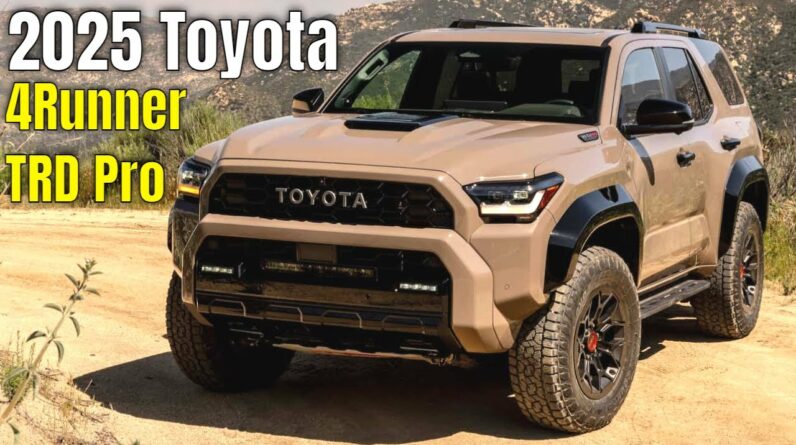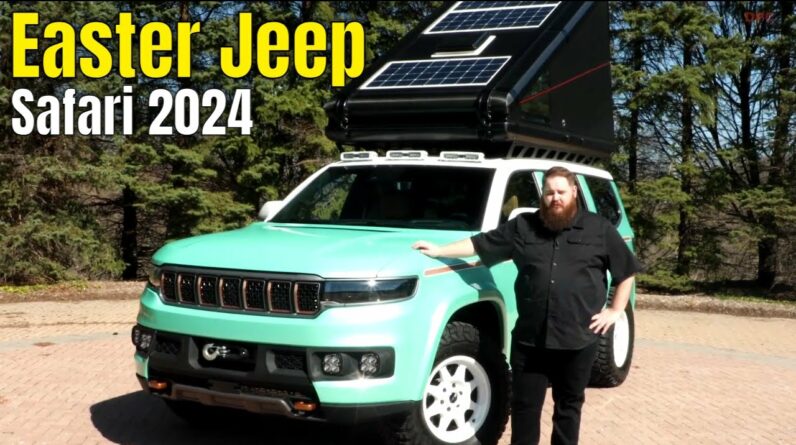The all-new Tundra will offer two impressive new powertrains: a twin-turbo V6 engine and a hybrid twin-turbo V6. What may be surprising to some is the hybrid powertrain will be the most powerful of the two. Mated to both engines will be a 10-speed Electronically Controlled Automatic Transmission with intelligence (ECTi). The new 10-speed features a sequential shift mode, uphill/downhill shift logic and TOW/HAUL driving modes.
Exterior 0:00
Interior 0:41
Driving 1:50
Calling the twin-turbo V6 a “base” engine just doesn’t seem right. Its aluminum block features a displacement of 3,445cc via an 85.5mm bore and 100mm stroke. The 24-valve, Dual Overhead Cam V6 is chain-driven and features Dual VVTi systems. Thanks to the water-cooled intercooler keeping turbo temperatures down, the high-output V6 engine improves on the outgoing V8 engine in every way with impressive performance figures: 389 horsepower and 479 lb.-ft. of torque. SR grades utilize standard i-FORCE tuning to produce 348 horsepower and 405 lb.-ft. of torque.
An all-new truck on an all-new chassis requires a fresh approach to suspension. The most noteworthy change to handling and performance is no doubt the new multi-link rear suspension, which ditches leaf springs in favor of coil springs.
Ride comfort, straight-line stability and overall handling dynamics are improved with the multi-link rear suspension, along with towing capability. The maximum towing capacity for Tundra increases 17.6% over the previous generation to 12,000 pounds. The maximum payload increases to 1,940 pounds, which is an improvement of more than 11% compared to the previous generation.
The overall structure of the new frame and the multi-link rear suspension allowed engineers to adjust the placement of the shock absorbers, which are mounted outside the frame rails for improved efficiency and enhancement to roll damping and towing performance. And, as one more good measure, the lateral control arm provides increased lateral rigidity.
To further enhance the ride comfort, driving performance and overall durability, a newly developed double wishbone front suspension is fitted on Tundra. The front suspension benefits from a kingpin offset angle reduction to enhance straight-line stability and high-speed driving. The caster trail has been enlarged from 25.4mm (1 inch) on the previous generation to 34.1 mm (1.34 inches) for added stability. To improve cornering, roll steer has been reduced by 25% compared to the benchmarks, and the roll height center has been elevated (152mm compared to 104mm, or roughly 6 inches compared to 4 inches) to reduce body roll.
Tundra will feature standard twin-tube shocks at the front and rear of each truck. The shock absorbers feature triple-oil seals and extended dust covers for added protection and durability. Beefy new aluminum forged knuckles are employed to optimize weight. To help prevent corrosion and stress cracks, steel inserts reinforce the ball joints. For TRD Off-Road packages, monotube Bilstein shocks improve damping for on- and off-highway driving.
For maximum off-road performance, TRD Pro grades are fitted with 2.5-inch diameter FOX internal bypass shocks that stand at the ready. The front FOX shocks provide the truck with a 1.1-inch front lift. The aluminum-bodied front and rear shocks feature piggyback reservoirs to house additional oil for improved off-road performance in the most demanding terrain. The shocks use a new polytetrafluorethylene-infused (PTFE) Fox shock fluid to improve on-road comfort. This fluid includes microscopic particles infused with the oil to reduce friction.
TRD Pro also gains a few additional off-road attributes, including a new TRD Pro front stabilizer bar, red painted suspension parts, TRD aluminum front skid plate along with additional underbody protection and unique Falken tires.
The multi-link rear suspension provided the flexibility for the engineers to add Tundra’s new air suspension system to the rear of the truck. Available on certain grades, the system features automatic and manual leveling functions. It features height modes for High, Low and Normal. The High setting is designed for slow-speed off-road driving, and it will return to Normal height if the truck exceeds 18 mph; it also optimizes damping to reduce roll rigidity for off-road driving. Low height mode allows for ease of loading and unloading, and it will return to Normal height once the truck exceeds speeds of 8 mph.
Adaptive Variable Suspension (AVS) system is also available or the first time on Tundra. It is designed to adjust damping force based on ever-changing road conditions, whether it be a large pothole, bump or small rock. The linear-solenoid-type AVS features built-in actuators in the front and rear shock absorbers to continuously change damping force based on the conditions, all to enhance handling, stability and comfort.
#toyotatundra
Get More Great Car Videos – Subscribe: https://goo.gl/BSIaFc







